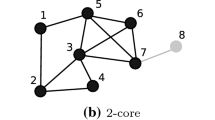Abstract
This paper provides decomposition algorithms for locating minimal cuts in a large directed network. The main theorem provides several cases for the algorithms. In the worst case, it is shown that the efficiency of one of the proposed algorithms is of the same order as a no-decomposition algorithm. As in linear programming, the obvious advantage of the proposed decomposition procedure is its ability to potentially handle larger problems than a no-decomposition algorithm.
Similar content being viewed by others
References
M.S. Bazaraa and J.J. Jarvis,Linear programming and network flows (Wiley, New York, 1977).
B.V. Cherkasky, “Algorithm of construction of maximal flow in networks with complexity of O(V2√E) Operations”,Mathematical Methods of Solution of Economical Problems 7 (1977) 117–125.
T. Cheung, “Computational comparison of eight methods for the maximum network flow problem”, Tech. Rep. No. 78-07, University of Ottawa, Ontario, Canada (1978).
E.A. Dinic, “Algorithm for solution of a problem of maximum flow in a network with power estimations”,Soviet Mathematics 11 (1970) 1277–1280. [Translation of the Pure Mathematics Section of the Doklady Akademii Nauk SSSR.]
J. Edmonds and R.M. Karp, “Theoretical improvement in algorithmic efficiency for network flow problems”,Journal of the Association for Computing Machinery 19 (1972) 248–264.
S. Even, “The max flow algorithm of Dinic and Karzanov: An exposition”, MIT/LCS/TM-80, Cambridge, MA (1976).
L.R. Lord and D.R. Fulkerson,Flows in networks (Princeton University Press, Princeton, N.J., 1962).
Z. Galil, “A new algorithm for the maximal flow problem”,Proceedings, 19th IEEE Symposium on Foundation of Computer Science (1978) 231–245.
Z. Galil and A. Naamad, “Network flow and generalized path compression”,The 11th Annual ACM Symposium on Theory of Computing (1979) 13–26.
R.E. Gomory and T.C. Hu, “Multiterminal network flows”,Journal of the Society for Industrial and Applied Mathematics 9 (1971) 551–570.
T.C. Hu,Integer programming and network flows (Addison-Wesley, Reading, MA, 1969).
J.J. Jarvis,Optimal attack and defense of a command and control communications network, Ph.D. Dissertation, The Johns Hopkins University (1968).
J.J. Jarvis and J.B. Tindall, “Minimal disconnecting sets in directed multicommodity networks”,Naval Research Logistics Quarterly 19 (1972) 681–690.
P.S. Jensen, “Optimum network partitioning”,Operations Research 19 (1971) 916–932.
A.V. Karzanov, “Determining the maximal flow in a network by the method of preflows”,Soviet Mathematics 15 (1974) 434–437. [Translation of the Pure Mathematics Section of the Doklady Akademii Nauk SSSR.]
B. Kinariwala and A.G. Rao, “Flow switching approach to the maximum flow problem: I”,Journal of the Association for Computing Machinery 24 (1977) 630–645.
P.M. Lin and B.S. Leon, “Improving the efficiency of labeling algorithms for maximum flows in networks”,Proceedings of IEEE International Symposium on Circuits and Systems (1974) 162–166.
V.M. Malhotra, M.P. Kumar and S.N. Maheswari, “An O(|V|3) algorithm for finding maximum flows in networks”,Information Processing Letters 7 (1978) 277–278.
D.R. Shier, “A decomposition algorithm for optimality problems in tree-structured networks”,Discrete Mathematics 6 (1973) 175–189.
S. Tufekci,Decomposition of large-scale single commodity network flow problems, Ph.D. Dissertation, Georgia Institute of Technology (1977).
N. Zadeh, “Theoretical efficiency of the Edmonds—Karp algorithm for computing maximal flows”,Journal of the Association for Computing Machinery 19 (1972) 184–192.
N. Zadeh, “More pathological examples for network flow problems”,Mathematical Programming 5 (1973) 217–224.
Author information
Authors and Affiliations
Rights and permissions
About this article
Cite this article
Jarvis, J.J., Tufekci, S. Decomposition algorithms for locating minimal cuts in a network. Mathematical Programming 22, 316–331 (1982). https://doi.org/10.1007/BF01581046
Received:
Revised:
Issue Date:
DOI: https://doi.org/10.1007/BF01581046




